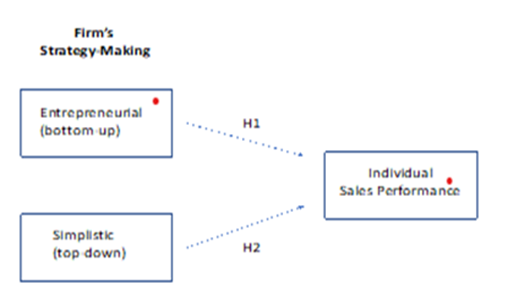
ABSTRACT
This article addresses the interrelationships between the strategy-making of a firm and the sales performance of its business-to-business (B2B) salespeople. Analysis of the results from a survey of B2B salespeople suggests that entrepreneurial (bottom-up) strategy-making is a more powerful influencer of individual B2B sales performance than simplistic (top-down) strategy-making.
INTRODUCTION
The early work of Morris et al. (1990) on the nexus of entrepreneurship and personal selling suggested that entrepreneurship could enhance the business-to-business (B2B) salesforce performance. However, research on entrepreneurship and B2B sales has remained relatively limited (Matthews et al., 2018). The study described in this article addresses the gap by analysing the efficacy of a firm's decision-making approaches in improving sales performance. Approaches may range from simplistic strategy-making (SSM) to opportunity-focused entrepreneurial strategy-making (ESM) (Lumpkin & Dess, 2006).
The purpose of the study was to explore the research question:
What are the interrelationships between individual B2B sales performance and (i) entrepreneurial strategy-making, and (ii) simplistic strategy-making?
THEORETICAL FRAMEWORK
Strategy-Making
Barney's (1991) resource-based view (RBV) of developing innovative, risk-accepting, and proactive initiatives such as entrepreneurial selling (Verreynne, 2006) suggests that senior management should support the sales staff both financially and organisationally. The critical requirement of ESM is that top management provides the direction, scope, and resources to enable employees to undertake innovative and creative actions (Dess et al., 1997). Leigh et al. (2011) suggested that these entrepreneurial initiatives can improve sales performance.
Dess et al. (1997) argued that ESM is viable regardless of the organisation's participation, adaptability, and simplicity in emergent strategy formulation. They defined ESM as "opportunity seeking, risk-taking and decisive action catalysed by a strong leader" (Dess et al., 1997, p. 679). This simplistic strategy relies on well-established methods, conventional solutions, routines, and values (Dess et al., 1997). It is a "top-down" method to ensure that behaviour at all operational levels is consistent with top management's intentions (Lumpkin & Dess, 1995).
Sales performance
Strong sales performance is a goal of all businesses seeking to optimise top-level revenue or bottom-line profit (Evans et al., 2012). Therefore, salesforce performance is a critical area of business research (Verbeke et al., 2011).
Numerous sales performance measurement scales have been developed to evaluate the performance of salespeople (Jones et al., 2007). Variables include motivation, competence, ability, individual characteristics, organisational elements, internal and external environments, skill levels, salesperson behaviours, sales technology, personality, inter-organisational relationships, attitude, and knowledge (Evans et al., 2012). Individual B2B sales performance also measures the quantitative outcomes of the sales process (e.g., revenue and profitability).
The following hypotheses were tested:
H1. A positive relationship exists between entrepreneurial strategy-making and individual B2B sales performance.
H2. A positive relationship exists between simplistic strategy-making and individual B2B sales performance, but it is weaker than the relationship between entrepreneurial strategy-making and individual B2B sales performance.

Figure 1 illustrates the conceptualised relationships between the constructs in this study.
RESEARCH METHODS
Sample
The target variable of the study was B2B sales performance. Salespeople in an organisation are usually easy to identify as they typically form a well-defined structural unit. Thus, the individual salesperson was designated as the unit of the target variable.
The study's target population was B2B salespeople. It included participants in financial service/insurance, consumer goods/retail, communications/IT, health care/medical, professional services, industrial, telecommunications, advertising, and property/real estate. All participants had at least three years of sales experience in critical sales roles.
Information about participants was collected via an online survey because of health concerns associated with the COVID-19 pandemic, the dispersed nature of the target participants, and the low cost of using online resources to reach the participants. The survey was emailed to 302 potential participants in 48 organisations throughout Australia. Data were collected during July-October 2020. A total of 252 completed surveys was received. The response rate (83.4%) was unusually high but explainable by the topic's importance and the prevailing government-imposed lockdowns.
Instruments
The survey was piloted among eight academic and seven industry-based sales practitioners to ensure that all questions were easily understood and were neutral. The constructs were measured using the five-point Likert scale within each item. Respondents were asked to choose one of five points ranging from 1 – "totally disagree" to 5 – "totally agree" for each item.
Items measured
The entrepreneurial and SSM measurement scales were constructed from the research conducted by Dess et al. (1997). That study analysed six items measuring strategy-making (entrepreneurial – 3 and simplistic – 3). Individual B2B sales performance, a dependent variable in this study, was tested as a reflective (perceptual) measure, distinct from an objective (actual) measure. Substantial evidence supports the use of self-evaluation in estimating a salesperson's performance (Gonzalez et al., 2014). Therefore, the seven-item scale for individual sales performance developed by Jones et al. (2007) was adopted in this study.
Statistical analysis
The hypotheses were tested and analysed using Partial Least Square – Structural Equation Modelling (PLS-SEM) based on the construct verification above. PLS-SEM is geared towards predictive analysis (Hair et al., 2019). The primary goal of PLS-SEM is to maximise the explained variance (R2) for all dependent variables (Hair et al., 2019). Therefore, the predictive orientation is appropriate for achieving the study's objectives. Furthermore, with PLS-SEM, a sample size of 200 respondents is sufficient to validate the model (Hair et al., 2019), a requirement satisfied in this study.
RESULTS
Construct reliability and validity
Organisational consistency demonstrates the reliability of a construct among items measuring it (Hair et al., 2019). Cronbach's alpha (CA) and composite reliability (CR) are two popular measures for determining this consistency (Hair et al., 2019). This study estimated the reliability of the extracted constructs. The findings indicated a reliability for all measures of greater than 0.70, as determined by CA scores and CR (Fornell & Larcker, 1981). The results included composite reliability (CR) and average variance extracted (AVE) values for the construct of interest. The data collected in the study confirmed the reliability of all the measures used.
Construct validity was indicated by the average variance extracted (AVE), which exceeded the cut-off of 0.5. Furthermore, discriminant validity, measured by the square root of a construct's AVE, was greater than its correlations with other constructs (Fornell & Larcker, 1981). These tests suggest that the measures used in this study were psychometrically sound.
Finally, the model's Goodness of Fit (GOF) indicated that the study's quantitative data fitted the measurement model well. In addition, the variables were tested for collinearity. The results fitted within the recommended acceptable range of 3.0 or less to account for multicollinearity (Hair et al., 2019).
Hypotheses testing results
The paths from ESM and SSM to individual B2B sales performance were investigated (See Table 1). The effect of ESM (β = .23, p < 0.001) was positive and significant for individual sales performance. The effect of SSM (β = .03, n.s.) was positive (just) but not significant for individual sales performance.
Table 1. Summary of the PLS-SEM path results

Overall, the model performed reasonably well in predicting individual sales performance (R2 = 0.30).
DISCUSSION
Hart (1991, 1992) and Dess et al. (1997) recognised the importance and significance of ESM and SSM for firm performance. This study continued that tradition but expanded on Dess et al. (1997) by considering sales performance at the individual salesperson's level. In addition, Dess et al. (1997) asserted that ESM is characterised by innovation, experimentation, risk-taking, and dynamism, which is consistent with the findings of this study.
In investigating possible relationships between the entrepreneurial and simplistic approaches to strategy-making and B2B sales performance, the study provides a strong case for associating ESM with better individual B2B sales performance. The findings suggest that the ESM correlates higher with individual sales performance than does simplistic strategy-making. This result is consistent with Dess et al. (1997), who found that ESM is moderately related to firm performance. In addition, Miller (1993) argued that SSM harms firm performance.
A firm's strategy-making approach can thus have an impact on the individual salesperson's performance. Top management needs to recognise and understand this. In particular, developing a "bottom-up" ESM approach involving lower- to middle-level employees, such as salespersons, can yield better individual performances (and, therefore, also a better firm-level performance). Thus, this study supports the findings of Burgelman (1983) and Kuratko et al. (2005), who posited that entrepreneurial behaviours and actions reside in organisations' middle echelons and positively influence firm performance.
CONCLUSIONS
Theoretical implications
This study suggests that ESM significantly affects performance at an individual employee level. Scholars have previously argued that ESM correlates positively with a company's financial performance (Dess et al., 1997). In addition, scholars have argued that a mix of entrepreneurial and SSM is associated with positive firm-level financial outcomes (Covin et al., 2006; Verreynne, 2006). For example, Hart (1991) reported that SSM produces more robust firm-level results than does entrepreneurial strategy-making. However, findings from this study, based on individual B2B salespeople, suggest that these two strategy-making constructs have different effects on individual sales performance. Importantly, ESM has a stronger effect on individual sales performance than does simplistic strategy-making.
Finally, entrepreneurial decision-making in a dynamic working environment seems to support employees such as B2B salespeople working in an emergent, risk-accepting manner. This study discovered that ESM is directly and positively correlated with individual sales performance. It is also favoured by B2B salespeople.
Past B2B sales performance studies have found relatively low to modest variances (e.g., R2 between 10% and 20%) when testing various determinants and using a wide range of mediating and moderating variables (Bolander et al., 2015). As a result, it is not easy to predict B2B sales performance. Nevertheless, this study's individual sales performance variance (R2 = 0.30) suggests that entrepreneurial strategy-making can contribute to more robust individual sales performance.
Managerial implications
Many firms in Australia operate in highly competitive business environments. To make their firms more competitive, senior management needs to consider creating a "bottom-up" approach to decision-making so as to encourage B2B salespeople to perform better.
This research should assist senior management by helping them to understand better the relationship between a firm’s strategy-making and individual sales performance.
Limitations and future research
This study highlights the value of conducting additional research on the determinants of individual sales performance. However, the study has several limitations that future researchers should consider.
First, it used a non-random judgment sampling frame, covered a single country, and was conducted during a global pandemic. These are the main constraints on the generalisability of its findings.
Second, due to time constraints, a cross-sectional study design was chosen.
Third, several constructs and items were introduced into the PLS-SEM path analysis to gauge the potential effects of the ESM and SSM → sales performance relationship. However, the study did not examine the potentially distorting effects of control variables such as age, gender, size, industry, or tenure on the overall path relationship.
REFERENCES
Barney, J. (1991). Firm resources and sustained competitive advantage. Journal of Management, 17(1), 99-120.
Bolander, W., Satornino, C. B., Hughes, D. E., & Ferris, G. R. (2015). Social networks within sales organizations: Their development and importance for salesperson performance. Journal of Marketing, 79(6), 1–16.
Burgelman, R. A. (1983). Corporate Entrepreneurship and Strategic Management: Insights from a process study. Management Science, 29(12), 1349–1364.
Covin, J. G., Green, K. M., & Slevin, D. P. (2006). Strategic process effects on the entrepreneurial orientation–sales growth rate relationship. Entrepreneurship Theory and Practice, 30(1), 57–81.
Dess, G. G., Lumpkin, G. T., & Covin, J. G. (1997). Entrepreneurial strategy making and firm performance: Tests of contingency and configurational models. Strategic Management Journal, 18(9), 677–695.
Evans, K. R., McFarland, R. G., Dietz, B., & Jaramillo, F. (2012). Advancing sales performance research: A focus on five under-researched topic areas. Journal of Personal Selling & Sales Management, 32(1), 89–105.
Fornell, C., & Larcker, D. F. (1981). Evaluating structural equation models with unobservable variables and measurement error. Journal of Marketing Research, 18(1), 39–50.
Gonzalez, G. R., Claro, D. P., & Palmatier, R. W. (2014). Synergistic effects of relationship managers’ social networks on sales performance. Journal of Marketing, 78(1), 76–94.
Hair, J. F., Risher, J. J., Sarstedt, M., & Ringle, C. M. (2019). When to use and how to report the results of PLS-SEM. European Business Review, 31(1), 2–24.
Hart, S. L. (1991). Intentionality and autonomy in strategy-making process: Modes, archetypes, and firm performance. In P. Shrivastava, A. Hall & J. Dutton (Eds.), Advances in Strategic Management, Vol. 7, pp. 97–127. Greenwich, CT: JAI Press.
Hart, S. L. (1992). An integrative framework for strategy-making processes. Academy of Management Review, 17(2), 327–351.
Jones, E., Chonko, L., Rangarajan, D., & Roberts, J. (2007). The role of overload on job attitudes, turnover intentions, and salesperson performance. Journal of Business Research, 60(7), 663–671.
Kuratko, D. F., Ireland, R. D. Covin, J. G., & Hornsby, J. S. (2005). A model of middle-level managers’ entrepreneurial behavior. Entrepreneurship Theory and Practice, 29(6), 699–716.
Leigh, T. W., Cron, W. L., Baldauf, A., & Grossenbacher, S. (2011). The strategic role of the selling function. In The Oxford Handbook of Strategic Sales and Sales Management. Edited by D. W. Cravens, K. Le Meunier‐FitzHugh, and N. F. Piercy (Eds). Oxford University Press, 490-518.
Lumpkin, G. T., & Dess, G. (1995). Simplicity as a strategy-making process: The effects of stage of organizational development and environment on performance. Academy of Management Journal, 38(5), 1386–1407.
Lumpkin, G. T., & Dess, G. (2006). The effect of ‘simplicity’ on the strategy–performance relationship: A note. Journal of Management Studies, 43(7), 1583–1604.
Matthews, R. S., Chalmers, D. M., & Fraser, S. S. (2018). The intersection of entrepreneurship and selling: An interdisciplinary review, framework, and future research agenda. Journal of Business Venturing, 33(6), 691–719.
Miller, D. (1993). The architecture of simplicity. Academy of Management Review, 18(1), 116–138.
Morris, M. H., Avila, R., & Teeple, E. (1990). Sales Management as an Entrepreneurial Activity. The Journal of Personal Selling and Sales Management, 10(2), 1–15.
Verbeke, W., Dietz, B., & Verwaal, E., (2011). Drivers of sales performance: a contemporary meta-analysis. Have salespeople become knowledge brokers? Journal of the Academy of Marketing Science, 39(3), 407–428.
Verreynne, M. L. (2006). Strategy-making process and firm performance in small firms. Journal of Management & Organization, 12(3), 209–222.
BIOGRAPHY


Dr John Edwards has over 35 years’ experience working in business and education industries. He was the Director of Corporate and Executive Education Director at Macquarie Graduate of Management (MGSM); held Marketing roles at Westpac, Citibank, Advance Bank, Diageo, and Kellogg’s. He completed his Master of Research in 2015, and PhD (on Corporate Entrepreneurship and Sales Performance) in May 2022. He has published articles in the Journal of Business Research.




